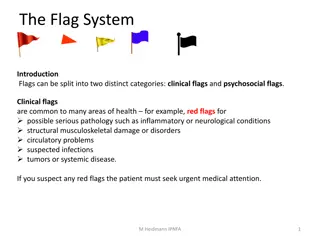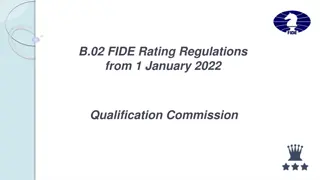Student Rating Criteria & Red Flags
Performance criteria guide for students rated on professionalism, technical skills, and communication in clinical education. Red flags indicate areas needing correction.
Download Presentation

Please find below an Image/Link to download the presentation.
The content on the website is provided AS IS for your information and personal use only. It may not be sold, licensed, or shared on other websites without obtaining consent from the author.If you encounter any issues during the download, it is possible that the publisher has removed the file from their server.
You are allowed to download the files provided on this website for personal or commercial use, subject to the condition that they are used lawfully. All files are the property of their respective owners.
The content on the website is provided AS IS for your information and personal use only. It may not be sold, licensed, or shared on other websites without obtaining consent from the author.
E N D
Presentation Transcript
CPI Web Instructions for Student Rating - Quick reference AUGUST 28, 2023
Performance Criteria Professionalism: Ethical Practice Technical/Procedural: Interventions: Mechanical and Electrotherapeutic Modalities Professionalism: Legal Practice Professionalism: Professional Growth Technical/Procedural: Interventions: Functional Training and Application of Devices and Equipment Interpersonal: Communication Business: Documentation Interpersonal: Inclusivity Business: Resource Management Technical/Procedural: Clinical Reasoning Technical/Procedural: Interventions: Therapeutic Exercise and Techniques
Red Flags Performance criteria considered foundational elements for clinical work. Rated based on level of education These are critical areas for all students, regardless of setting and typically need to be addressed with an appropriate education / action plan if there is a deficit. If area is not up to expected level given students education level, these issues are of concern and need to be addressed. Document Performance Concerns, Unsafe Events, and/or Incidents to be recorded in the box and check the Send Email to DCE box
Red Flags Red flags will require action to address: DCE will meet with CI/SCCE to discuss correction plan for student. Actions may include Remediation Extension of clinical education experience Development of learning plan Possible failing grade, which is assessed / assigned by the school Repeating of clinical rotation Dismissal from program
Performance Criteria Format Each section has Sample Behaviors which gives examples of the types of skills / behaviors related to each criteria These examples are guides but are not exclusive and list is not exhaustive. Clinical instructors should rate students on observed clinical performance Each criteria should be rated based on performance, unless the setting does not perform the specific criteria (i.e. Modalities)
Keys to rating 5 Keys to rating The student s level of supervision and caseload and where they fall on the rating scale The majority of behaviors that best represent the student s performance on the rating scale If the student s clinical performance spans multiple performance levels, consider where there is a preponderance of evidence and make your rating at that level Examples Student is able to perform proper patient education without assistance 75% of the time with non-complex patients and 50% of the time with complex patients. Student is independent in performing patient wheelchair to bed transfers safely 100% of the time with both complex and non-complex patients. Student is able to complete all tasks for intervention within allotted patient time, including intervention and documentation while maintaining 50% of entry level caseload.
Keys For Comments Be specific with comments. If the student is doing something either well or needs improvement, please be as detailed as possible. There are comment boxes for both areas under each Rating Anchor Remember HIPAA rules regarding patient information when writing feedback If there are issues to address, reach out to the DCE if you have not already, use the Remediation/Performance Optimization Plan box under the anchor to document the plan.
Web CPI Rating It is a rating scale (slide) ranging from Beginner to Beyond Entry Level Performance
Expected Levels Beginner Student requires direct supervision 100% of the time with constant monitoring and feedback with even simple tasks Performance of essential skills is inconsistent and student is ineffective at clinical decision making. Student cannot carry the caseload of entry level PTA This is typically the starting point for students at first clinical rotation
Expected Levels Advanced Beginner Student requires direct supervision 75% of the time with simple tasks and 100% of the time for complex tasks Student demonstrates consistency in developing proficiency with simple tasks, clinical problem solving, interventions, and related data collection Student is unable to perform more complex tasks, clinical problem solving, interventions, or related data collection without guidance and / or supervision Student can start to carry some of the caseload of expected level for full-time entry-level clinician
Expected Levels Intermediate Student requires direct supervision less than 50% of the time with simple tasks and 75% of the time for complex tasks Student demonstrates proficiency with simple tasks, clinical problem solving, interventions and data collection Student is developing the ability to consistently perform more complex tasks, clinical problem solving, interventions, or related data collection without guidance and / or supervision Student is able to manage 50% of the caseload of expected level for full-time entry-level clinician
Expected Levels Advanced Intermediate Student requires direct supervision less than 25% of the time working with new patients or patients with complex conditions and is independent with simple tasks and conditions Student demonstrates proficiency and consistency with simple tasks, clinical problems solving, interventions and data collection Student requires occasional assistance / cueing for complex tasks, clinical problem solving, interventions, or related data collection Student is able to manage 75% of the caseload of full-time entry-level clinician
Expected Levels Entry Level Student is capable of completing tasks, clinical problem solving, interventions and data collection independently, consistently and efficiently for simple and complex tasks / conditions under the general supervision of a physical therapist Student consults with others to resolve unfamiliar or ambiguous situations Student is able to manage 100% of the caseload of a full-time PTA at entry-level caseload in an efficient and cost-effective manner under the direction of a physical therapist When a student meets Expected entry level and exceeds expectations, utilize the beyond entry level to document that accomplishment.
Special Note CPI 2.0 based all 14 rating categories on the below criteria. CPI 3.0 the first three professional categories are not based on the below criteria, but continue to use the below as anchors when rating the other 8. Caseload Skill level Complexity level of patients Level of Supervision required Amount of Assistance required If the student does not meet the minimum requirements due to extenuating circumstances, please explain with details in the comments section. These issues include but are not limited to: Complex patient population Unique patient population Unique clinic environment
Items To Think About Entry- Level clinician is the expected level of a recent graduate from an accredited program with a new license. It is not based on a seasoned clinician with years of experience in the field / setting When considering if they are entry-level, think about: Would they be qualified for hire? Would you be comfortable with them treating your patients or loved ones independently?
Keys to Completion of Web CPI Rate the student in all 11 categories with comments related to justification for rating Completion of comments including areas of strength and areas needing improvement Sign the evaluation Read the students evaluation and sign off that you read the student s self-evaluation
Expected levels at Conclusion PTA 142 (Fall Second Rotation) No significant concerns noted at the final evaluation. Items 1-11 will be rated at Intermediate performance or above on the rating scale at the final evaluation Student should be managing at least 50% of the expected caseload of an entry-level clinician No more than one documented safety issue during the clinical rotation Comments made by the clinical instructor should support the score. Comments are required when an item is rated below passing or the significant concerns box is checked.
Expected levels at Conclusion PTA 152 (Spring Final Rotation) No significant concerns noted at the final evaluation Items 1-11 will be rated at Entry-level performance on the rating scale at the final evaluation Student should be managing a full case load of an entry-level clinician No more than one documented safety issue during the clinical rotation Comments that support scoring (comments are required when the student is below entry level and/or significant concerns box is checked)
Additional Training / reference APTA CI Training CI/SCCE Training CPI Web Login CPI Login Sac City PTA Program Clinical Education https://scc.losrios.edu/academics/physical-therapist-assistant-program-details/clinical- education
If you have questions or need any assistance, don t hesitate to contact the DCE Millie Burns, PTA, DCE Sacramento City College PTA Program burnsm@scc.losrios.edu (916) 558-2298























